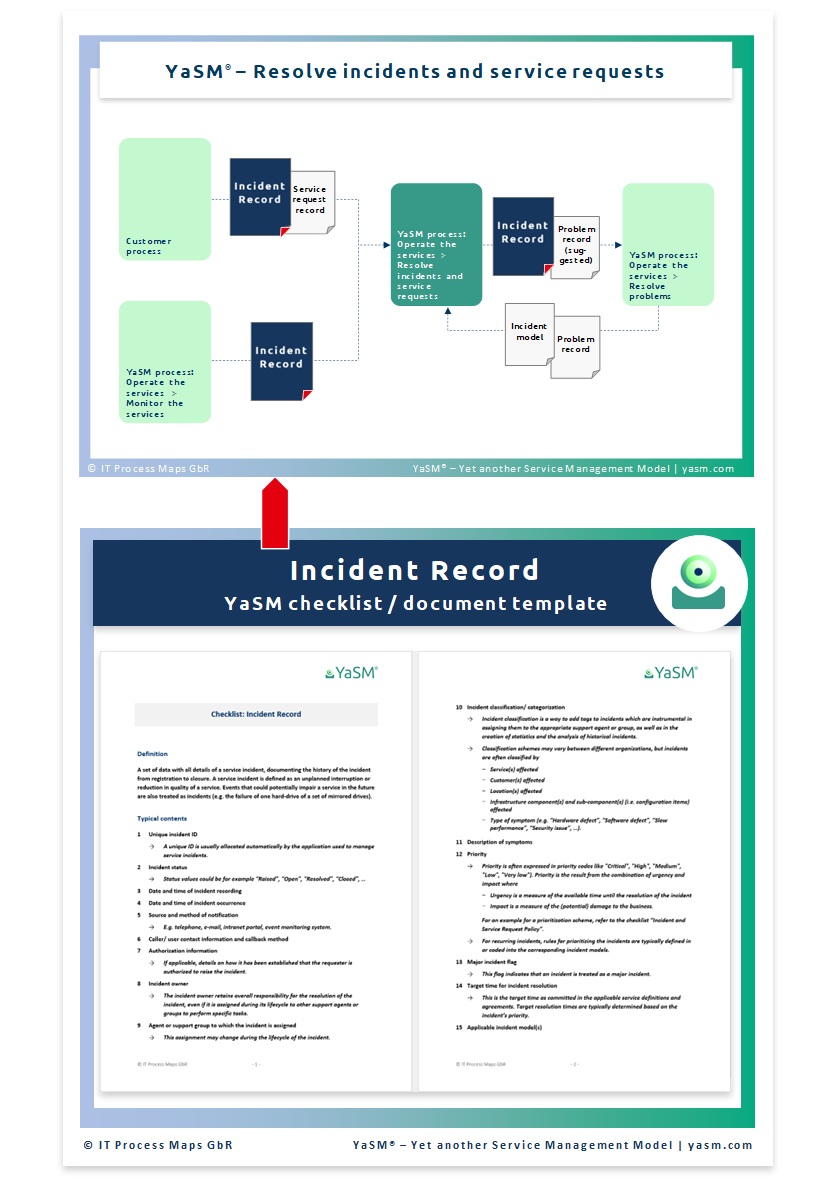Incident Record - Template
Definition
An incident record is a set of data with all details of a service incident, documenting the history of the incident from registration to closure. A service incident is defined as an unplanned interruption or reduction in quality of a service. Events that could potentially impair a service in the future are also treated as incidents (e.g. the failure of one hard-drive of a set of mirrored drives).
Related YaSM service management process: Resolve incidents and service requests
More checklists and document templates: Service management checklists
Typical contents
An incident record typically contains the following information:
| Content | Description |
|---|---|
Unique incident ID |
A unique ID is usually allocated automatically by the application used to manage service incidents. |
Incident status |
Incident status values could be for example "Raised", "Open", "Resolved", "Closed", ... |
Incident recording |
Date and time of incident recording. |
Incident occurrence |
Date and time of incident occurrence. |
Source and method of notification |
E.g. telephone, e-mail, intranet portal, event monitoring system. |
Contact information |
Caller/ user contact information and callback method. |
Authorization information |
If applicable, details on how it has been established that the requester is authorized to raise the incident. |
Incident owner |
The incident owner retains overall responsibility for the resolution of the incident, even if it is assigned during its lifecycle to other support agents or groups to perform specific tasks. |
Assignment |
Agent or support group to which the incident is assigned. This assignment may change during the lifecycle of the incident. |
Classification/ categorization |
Incident classification is a way to add tags to incidents which are instrumental in assigning them to the appropriate support agent or group, as well as in the creation of statistics and the analysis of historical incidents.
Classification schemes may vary between different organizations, but incidents are often classified by
|
Symptoms |
Description of symptoms. |
Priority |
Priority is often expressed in priority codes like "Critical", "High", "Medium", "Low", "Very low"). Priority is the result from the combination of urgency and impact where
For an example for a prioritization scheme, refer to the checklist "Incident and Service Request Policy". For recurring incidents, rules for prioritizing the incidents are typically defined in or coded into the corresponding incident models. |
Major incident flag |
This flag indicates that an incident is treated as a major incident. |
Target time for incident resolution |
This is the target time as committed in the applicable service definitions and agreements. Target resolution times are typically determined based on the incident’s priority. |
Incident model(s) |
Applicable incident model(s). |
Links to related incident records
Links to related event records
Links to related problem records
Links to related change records
| |
Escalation |
Functional escalation:
Hierarchic escalation
|
Status changes |
This section records incident status changes (for example from "open" to "resolved"). |
Activity log/ tasks assigned to the incident |
Most applications for managing incidents allow maintaining a simple log of steps carried out to resolve the incident. Some systems, however, also provide the means to assign "tasks" to incidents. Akin to the incidents they are assigned to, tasks are typically characterized by properties like name, description, owner, priority, etc. and contain a status history and activity log of their own. |
Incident closure |
Closure information. |
Resolution type |
Elimination of the underlying cause vs. application of a workaround. If the incident was resolved by applying a workaround: Indication of the applied workaround. |
Problems raised |
A problem record must be raised, for example
|
Customer feedback |
Confirmation from the customer or user that the incident has been resolved results from a satisfaction survey if one has been conducted. |
Additional information |
Notes and additional information. |
Status values and lifecycle
(This information is included in the lifecycle diagram for the incident record contained in the YaSM® Process Map.)
Remark
- For particular types of recurring incidents, incident models describe how the incidents are to be resolved. In many cases, the handling of such incidents is supported by appropriately configured incident management tools (for example, there may be short-cuts to easily create certain types of incident records).
- The classification of incidents and problems should use the same scheme in order to support matching between incidents and problems - which is important, for example, for the identification of known errors and available workarounds during the resolution of an incident.
Notes
Is based on: YaSM "Incident record" template from the YaSM Process Map.
By: Stefan Kempter ![]() and Andrea Kempter
and Andrea Kempter ![]() , IT Process Maps.
, IT Process Maps.
Definition › Contents › Classification/ categorization › Priority › Escalation › Remark






